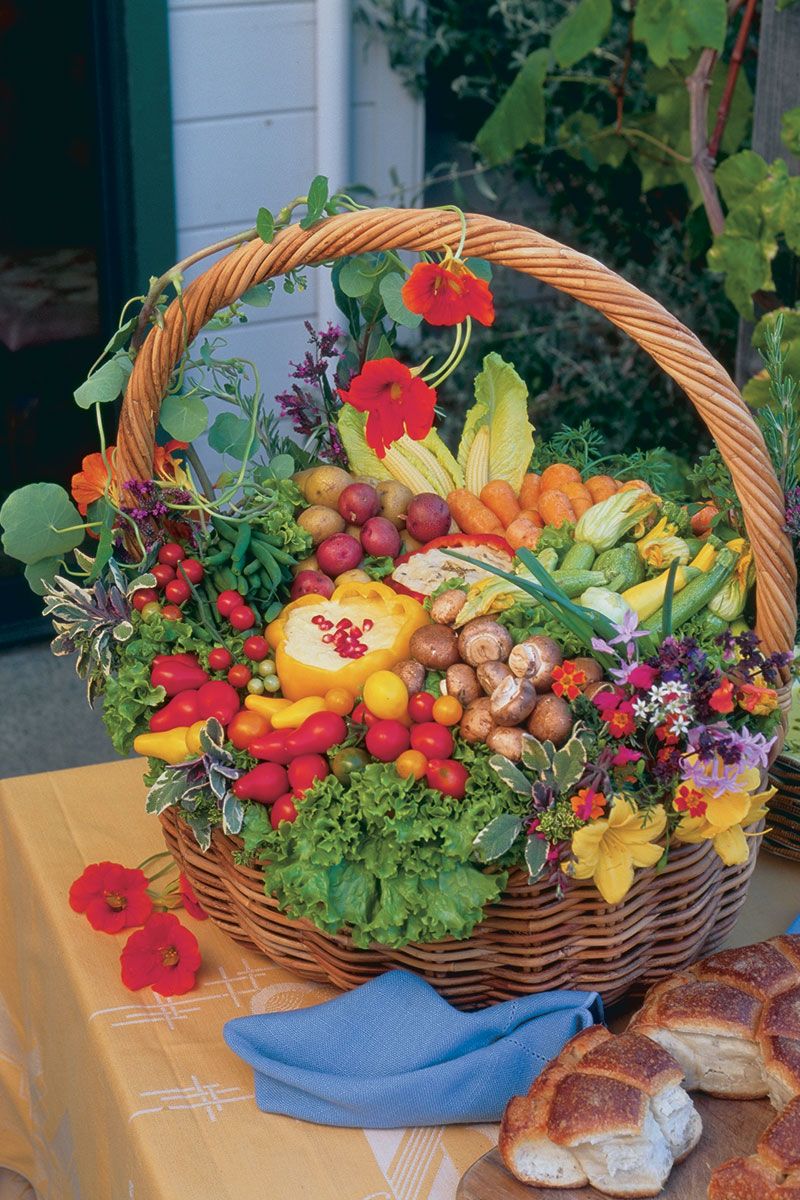
I love coming in from the garden with a beautifully arranged basketful of tender baby vegetables, fragrant herbs, and colorful edible flowers. They’re so fetching it’s hard to decide whether I’d rather eat them or just look at them.
That’s why, for parties and special occasions, I enjoy assembling a harvest basket of raw and cooked vegetables for snacking. I keep that just-in-from-the-garden feeling in mind as I work, aiming for a contrast of texture, color, and form.
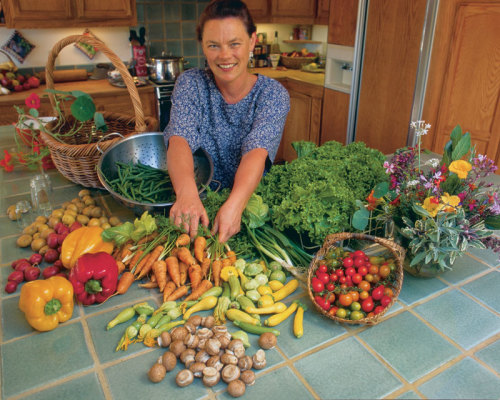 |
|
| The author with her basket fixings. | |
Vegetable and dip platters are always popular party food. But why settle for the usual when you can make something really spectacular? You can create a basket that’s sophisticated enough for a wedding buffet centerpiece, or casual enough for a backyard barbeque. Inspiration comes from having the best and freshest ingredients, so gather a palette of prime vegetables and let your creativity blossom.
Baby veggies are the best
I use whole small vegetables as much as possible. Not only do they have more eye appeal than grownup specimens, but they’re the right size for a one- or two-bite snack. Large vegetables like Romanesco broccoli, cauliflower, or heads of Belgian endive I break apart, then loosely reassemble.
What I put into a basket varies with the season. I always use carrots, bite-size potatoes, scallions, button mushrooms, edible flowers, and herbs. A spring basket might also include asparagus, baby beets, sugar snap peas, tiny sweet radishes, and Romanesco broccoli, which has tightly spiraled, conical, chartreuse heads. Green beans, cherry tomatoes, and tiny squash are summer staples.
When choosing herbs, I look for woody-stemmed ones with substantial leaves that resist wilting. Variegated lemon thyme, purple sage, rosemary, and a sprig of bay look wonderful. Curly parsley holds up well, too.
I use only flowers I know to be edible, and I make sure they were grown organically for culinary use. If I have nasturtiums, I wind a long flowering stem around the basket handle and tuck the end into a small water-filled jar nestled down in the basket. I often include individual nasturtium blossoms along with the vegetables because they can be dipped without falling apart. And I tuck a small bouquet of more unusual edible flowers into a jar: ‘Lemon Gem’ marigolds, violas, purple basil, calendula, runner beans, chives, and autumn sage (Salvia greggii).
When calculating quantities, I count on at least one piece of each vegetable per person. Of course, this varies depending on whether this is the sole appetizer for a hungry group, or part of a large buffet. Since an appearance of abundance is essential, I usually prepare more vegetables than I need; leftovers are easily put to use in salad or soup. One cup of dip serves eight to ten people.
Advance preparation takes the most time
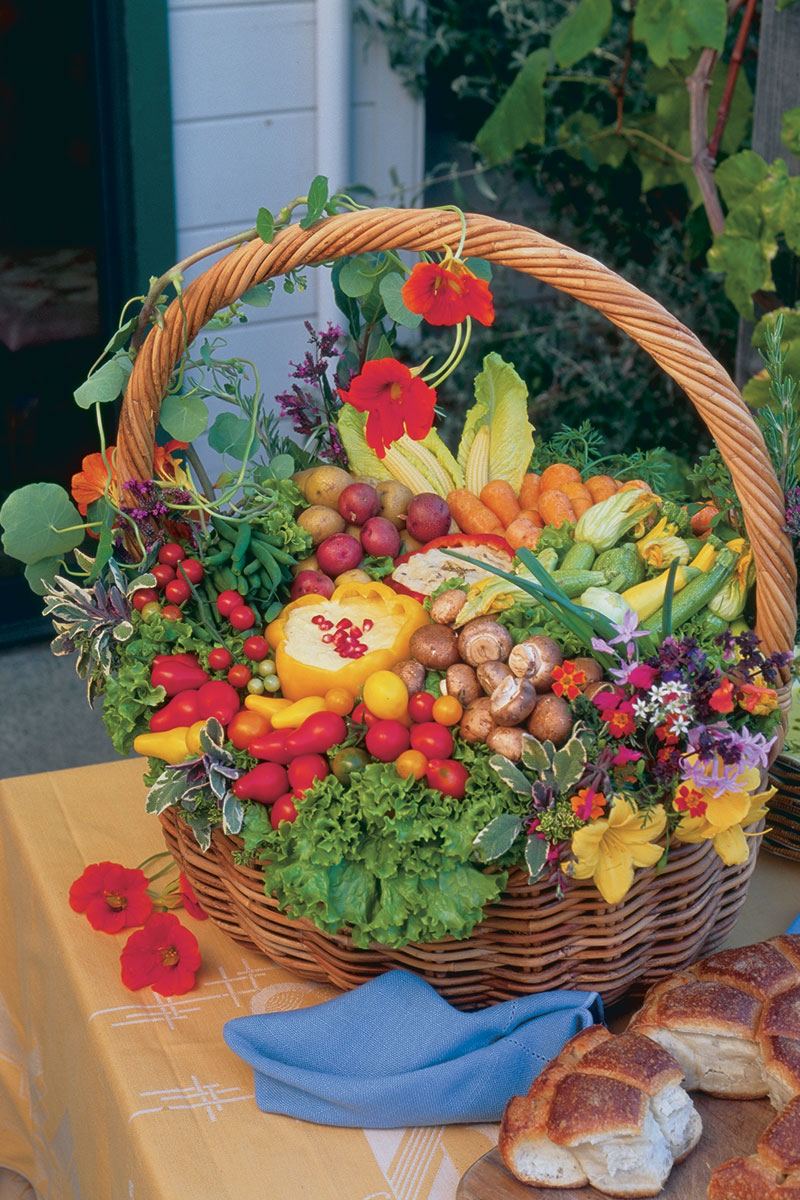 |
|
| At your next party, wow your guests with a spectacular display of fresh vegetables. | |
Remember, looks are as important as taste here, so for the greatest success, use the best-looking vegetables you can find. Don’t be deterred by the long list of suggested in gredients in the sidebar below, though. You can make a simple basket with three to five vegetables and a small bunch of edible flowers and herbs.
Most of the vegetables I leave raw. Potatoes and beets of course need to be cooked until tender. Some vegetables such as pea pods, asparagus, very fresh small green beans, and tiny summer squash can be used either way, but they sometimes benefit from a quick blanching to brighten their color and make them tender.
After prepping each ingredient, I place it in a separate ventilated ziplock bag and store in the refrigerator (except tomatoes, which are best kept at room temperature) until I’m ready to assemble the basket. If I’m taking the basket to a different location, I transport the vegetables in an ice chest, and put everything together on site.
| Good choices for the harvest basket Prepare each item separately. If you’re steaming or blanching vegetables, check them frequently to avoid overcooking. As soon as they’re tender, spread them out to cool. I always include the first eight ingredients and choose from the rest to round out the contents. |
|
| • Lettuce—Need four to five heads. • Bell peppers—Use as dip containers. • Herbs—Bind into bunches. • Edible flowers—Soak in cool water to debug, then drain. • Potatoes—Use bite-size potatoes. • Baby carrots—Trim tops and roots. • Scallions—Cut off most of the tops. • Button mushrooms—Brush clean. |
• Peas—Sugar snap or snow peas may need stringing. • Beans—Use stringless whole beans. • Cherry tomatoes—Leave stems on. • Broccoli or cauliflower—Break into florets, reassemble in basket. • Summer squash—Trim ends. • Asparagus—Use tender spears. • Beets—Golden beets don’t bleed. |
Assemble the basket at the last minute
A sturdy basket with a broad stable base is crucial; my usual choice is 12 in. x 18 in. x 6 in. I line the inside with plastic wrap, set a heavy casserole dish in the bottom for additional stability, and lay a clean, wet kitchen cloth in the casserole.
First to go in are several whole heads of frilly lettuce to make a lush, green base. If necessary, I set in some upside-down custard cups to elevate the dip containers. Next I nestle small jars of water along the edges of the basket and set the herb bunches in place. Then the dip containers go in, followed by the edible flowers and twining nasturtium stem. I wind the vine around the basket, securing as necessary with florist wire. Finally I tuck the vegetables in small groups among the lettuce leaves, gently arranging some on top. By now the basket’s quite heavy, so when I pick it up to set it in place, I support the bottom.
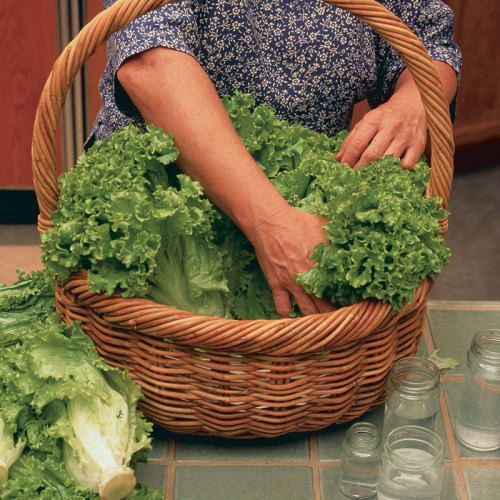 |
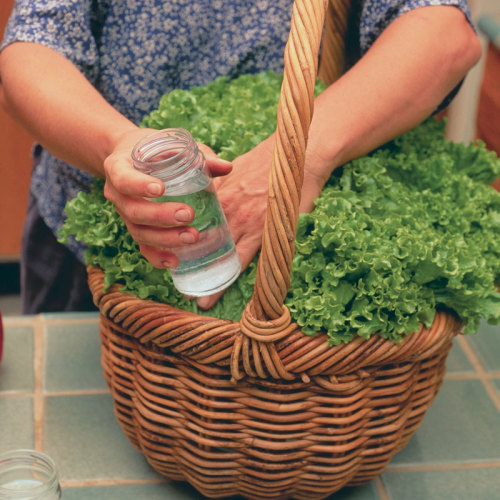 |
|
| 1. Fill the basket with frilly lettuce to make a bed for the main attractions. | 2. Next, set jars of water to hold herbs and edible flowers around the basket’s edge. | |
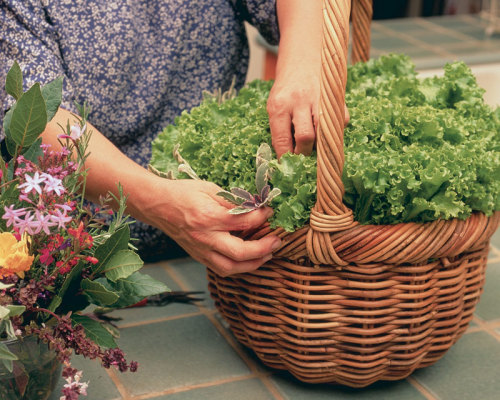 |
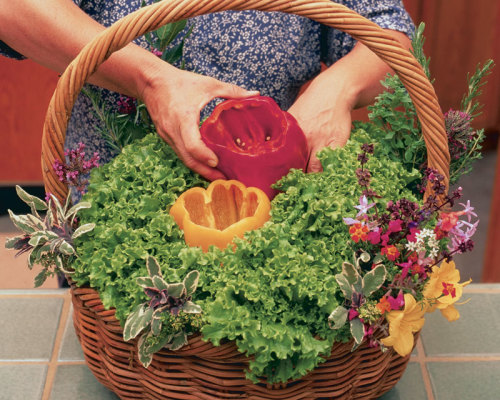 |
|
| 3. Tuck bunches of herb sprigs and flowers into the jars. | 4. Nestle the peppers in among the lettuces, but wait until the basket is assembled to fill them with dip. | |
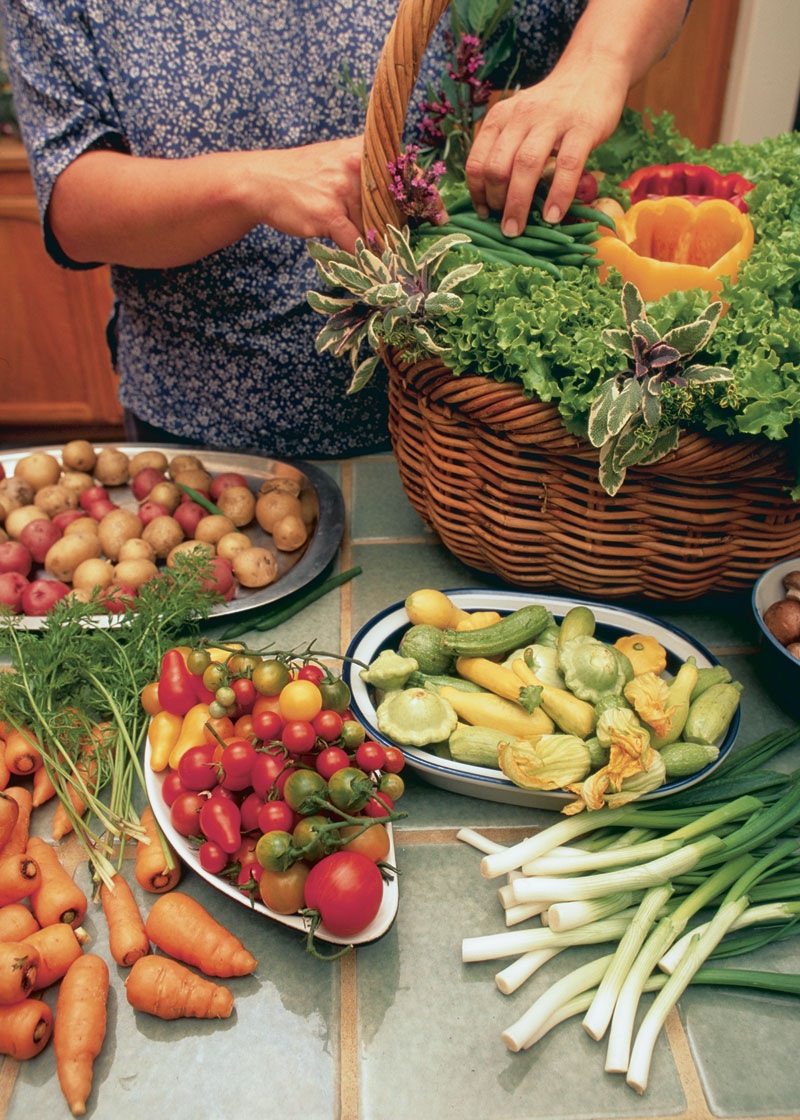 |
Once the party begins, I periodically check the basket’s appearance, replenishing dips and veggies as needed. Occasionally, people feel shy about digging into a basket that looks like a beautiful centerpiece. A stack of small plates and napkins nearby helps. If that doesn’t do the trick, I ask my only-too-willing husband to start the ball rolling.
Dips to serve with the basket: • Hummus |
by Frédérique Lavoipierre
October 1997
from issue #11


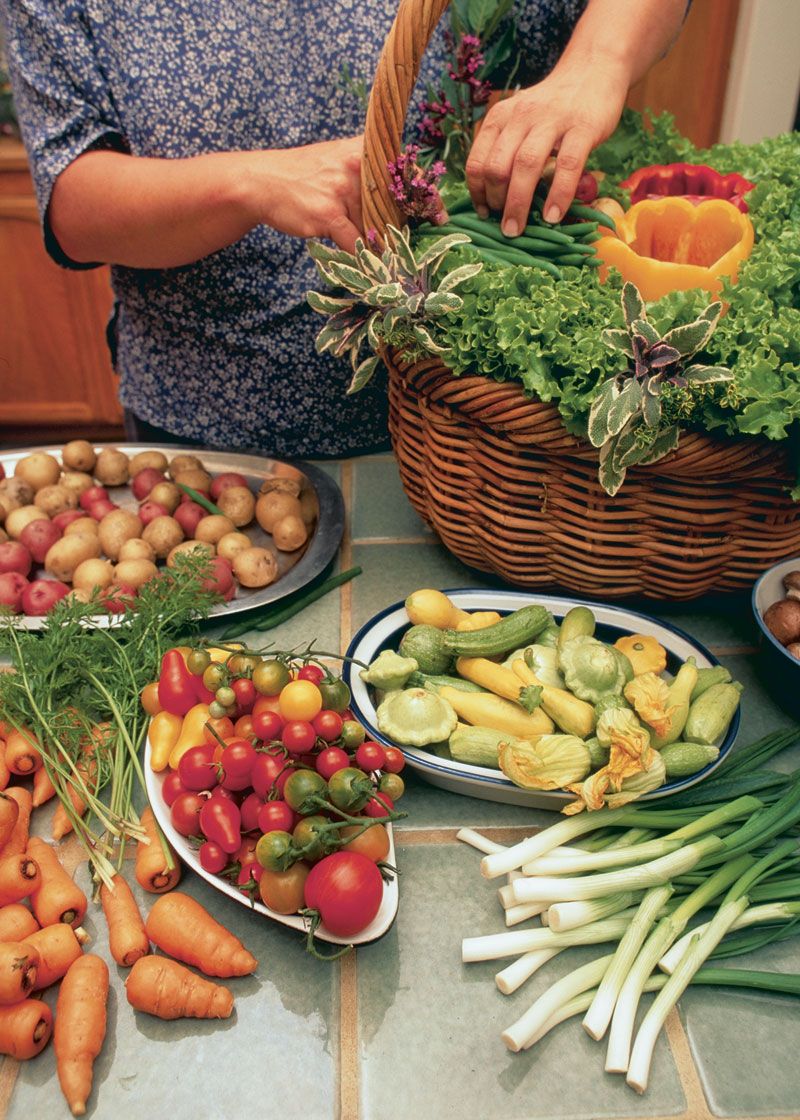
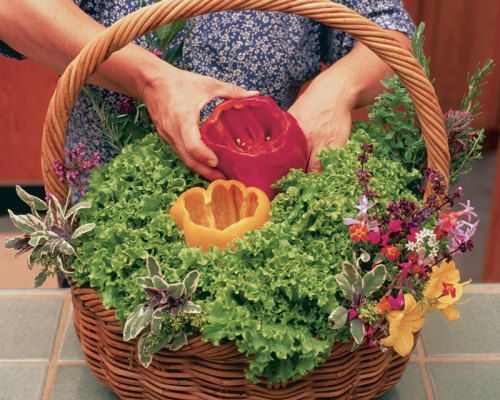
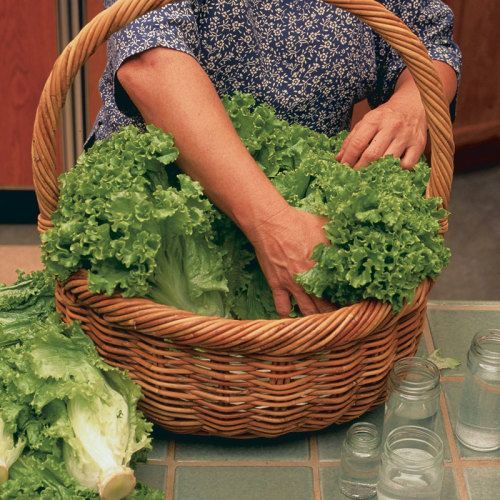
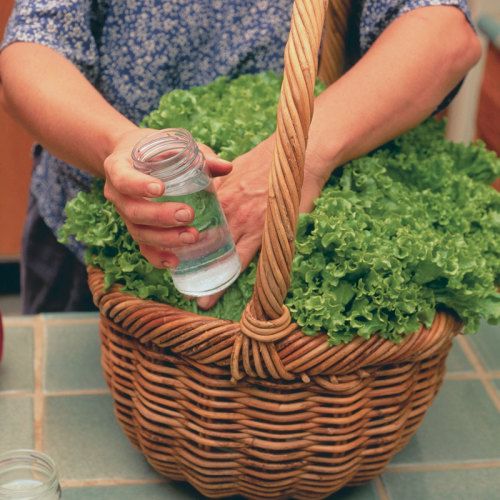
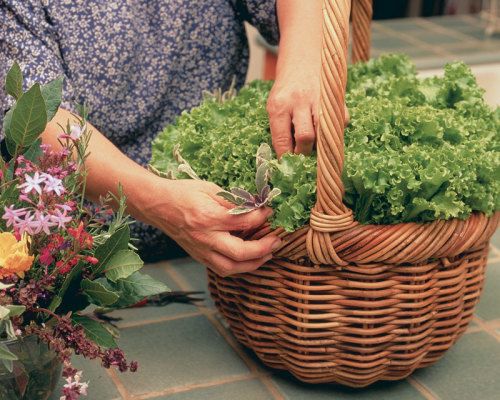

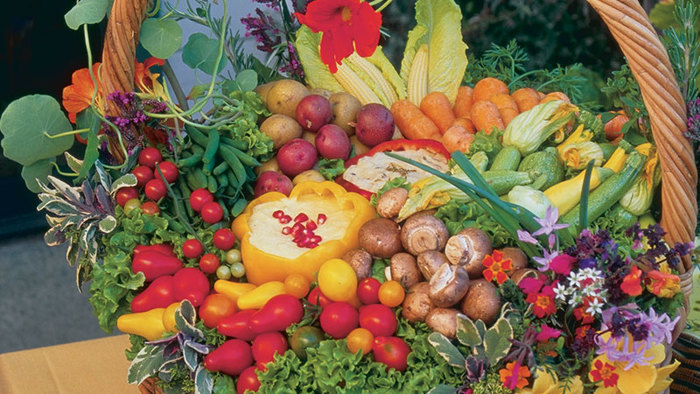














Comments
Log in or create an account to post a comment.
Sign up Log in